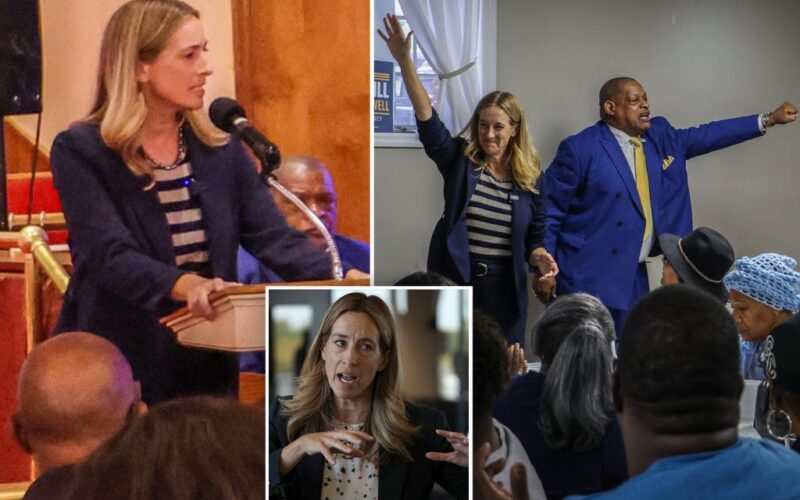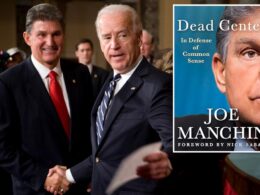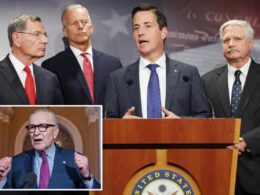New Jersey Democratic gubernatorial contender Rep. Mikie Sherrill is struggling to maintain support from black voters — a crucial group who could determine the next leader of the Garden State.
A staggering 15% of black voters were still undecided in the high-stakes governor’s race, according to a recent Quantus Insights poll, which noted she was underperforming with the core bloc that is typically loyal to Democrats and has been paramount to Democratic victories in past cycles.
In Newark, where nearly half of the population is black and less than one-quarter is white, many residents didn’t even know who she was or seemed too disillusioned by politics to vote.
“Who’s running? I don’t even know who’s running?” Yanissa Gaskin, 32, a paraprofessional at an elementary school in Newark, quipped.
“You start to lose hope with Democrats. That is who we are for,” the exasperated Jerseyan sighed.
Sonia Wolfrey, who lives in Newark and works in a cafe in nearby Irvington, another predominantly black municipality, raged that it “doesn’t matter” whom they vote for — because no politicians care about them.
“Newark, Irvington and parts of East Orange are forgotten about and they need to think about that when you’re begging for votes from these people in this town. You’re not addressing our issues,” the 38-year-old said.
“Both sides are f—k-ups to me,” she added, saying that she isn’t squarely in either the Democratic or Republican camp.
Chris Green, 55, an Irvington resident and father of one, noted he is “still on the fence about” how he will vote in the governor’s race.
“It’s the same old thing,” he explained. “A lot of people are just tired. They’re just tired of politics.”
Meanwhile, residents in tony parts of New Jersey sang a completely different tune.
“She has a presence around town, 100%! This is the blue bubble,” said Kelly, 45, a self-described “trad wife” in Montclair.
“She shows up at all the local events here. I saw her here at the M.C. art museum for the AAPI (Asian American and Pacific Islander) art event where she spoke,” she added.
“We see her around town all the time. I can’t even think who the other candidate is.”
“Do I know who she is?!” Gloria Averbuch, 74, a grandmother and Montclair resident, said when asked in a Whole Foods parking lot.
“If you could find someone here who doesn’t know her, I’d be amazed,” she added.
But the campaign for the lefty gubernatorial hopeful, who lives in Montclair, is downplaying concerns about a potential softening of support from black voters, and insists that it’s not taking anything or anyone for granted.
The campaign touted Sherrill’s partnerships with black communities, proposal to expand first-time homebuyer assistance programs, and plan to declare a state of emergency on energy costs.
“A Sherrill-Caldwell administration will give black New Jerseyans meaningful representation and ensure Trenton serves everyone,” Sherrill campaign spokesperson Sean Higgins told The Post.
New Jersey is one of the most diverse states in the country, with about 22% of its population Hispanic, 12% black and 10% Asian, according to the Census.
While black voters and Hispanic voters have historically leaned left, Henry De Koninck, a Democratic campaign ad strategist, observed there is a “nationwide realignment” happening.
“There’s really a nationwide realignment going on in terms of the percentage of support that Democrats are seeing from working-class and blue-collar voters, and particularly Hispanic and even African American voters,” he told The Post.
“What that does is it just changes the math,” De Koninck explained.
“That means that Mikie Sherrill’s team will have to do better in more traditionally Republican areas like Morris County and Somerset County and Hunterdon County, and I think she has the profile and is running the kind of campaign to do that.”
Oscar James II, who served on the Newark City Council from 2006 to 2010, said Sherrill’s message just isn’t resonating with black voters.
James penned a scathing op-ed in August titled, “I’m a Black NJ Democrat. This is why I can’t support Mikie Sherrill for governor.”
“Especially in the black community that I’ve seen her with, she goes in with the politicians and the Democratic and the Democratic chairs,” James explained to The Post.
“But everybody who the working people who are in these African American communities, in these black communities, they’re not at those events. They’re not the people showing up there. The everyday voters aren’t the ones.”
Other working-class New Jersey residents feel the same.
A 70-year-old voter in Montclair, who asked not to be identified, said she won’t vote for Sherrill.
“I’m white but I’m not rich,” she quipped. “Look at where the state is, people are working and working and the taxes are incredible. People can’t afford to retire in New Jersey.”
It is the Garden State’s black community, however, that could determine the outcome of the November 4 election.
“Ninety-two percent of black voters voted for Phil Murphy, not once, but twice,” Assemblywoman Shavonda Sumter, who chairs the Legislative Black Caucus, told The Post.
“Literally, it was the tipping point for the win in the second term and an outstanding win in the first term for Phil Murphy. It has not changed,” she insisted.
Sumter also rejected the naysayers and believes that Sherrill began making gains with black voters after her primary victory, calling her campaign operation “really impressive.”
Still, she acknowledges that Democrats have faced some slippage among black males nationally.
Sherrill’s outreach to the black community has included visits to Canaan Baptist Church as well as a Black Clergy Forum, and headlining a Get Out the Vote Rally in Atlantic City.








